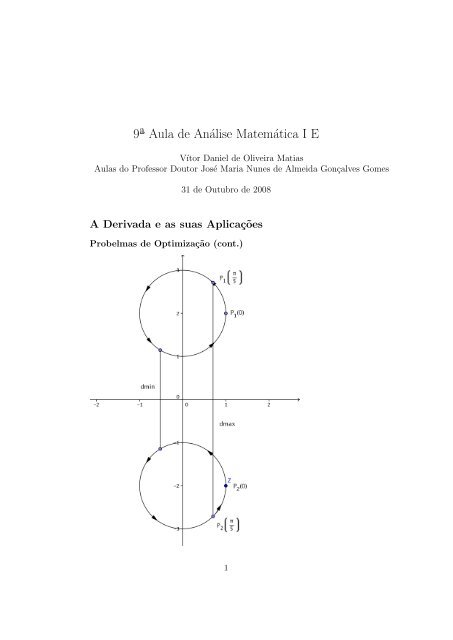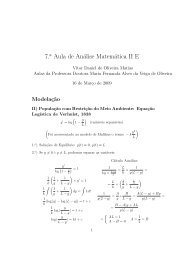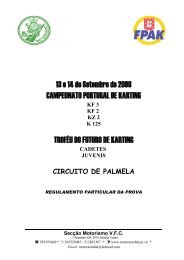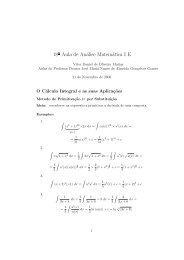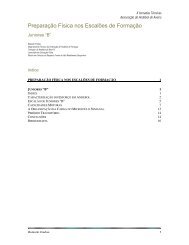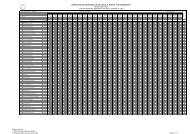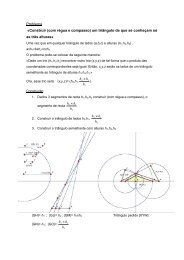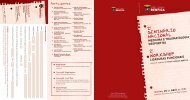Create successful ePaper yourself
Turn your PDF publications into a flip-book with our unique Google optimized e-Paper software.
9 <strong>Aula</strong> <strong>de</strong> <strong>Análise</strong> <strong>Matemática</strong> I E<br />
Vítor Daniel <strong>de</strong> Oliveira Matias<br />
<strong>Aula</strong>s do Professor Doutor José Maria Nunes <strong>de</strong> Almeida Gonçalves Gomes<br />
31 <strong>de</strong> Outubro <strong>de</strong> 2008<br />
A Derivada e as suas Aplicações<br />
Probelmas <strong>de</strong> Optimização (cont.)<br />
1
Para dois carrosseis e os pontos P1 e P2, com uma distancia entre si dada<br />
pela função d(t), preten<strong>de</strong>-se <strong>de</strong>scobrir em para que valores <strong>de</strong> t os pontos<br />
estão mais juntos e mais afastados<br />
P1(t) = (cos(t), sin(t)) + (0, 2) = (sin(t), +2 + cos(t))<br />
P2(t) = (sin(t), − cos(t)) + (0, −2) = (sin(t), −2 − cos(t))<br />
d(t) = P1 P2(t) =<br />
= (sin(t) − cos(t)) 2 + (4 + cos(t) + sin(t)) 2<br />
D(t) = d 2 (t) = (sin(t) − cos(t)) 2 + (4 + cos(t) + sin(t)) 2<br />
D ′ (t) = 2(sin(t)−cos(t)×(cos(t)+sin(t)+2(4 cos(t)+sin(t)(− sin(t)+cos(t)) =<br />
= 2(sin(t) − cos(t)) [(cos(t) + sin(t)) − (4 + cos(t) + sin(t))]<br />
<br />
−4<br />
D ′ (t) = 8(cos(t) − sin(t))<br />
5π<br />
x<br />
D<br />
0 π<br />
4<br />
4<br />
′ (t) + − +<br />
D(t) ↗ ↘ ↗<br />
Problema: Procura-se achar a area máxima para o triangulo que envolve<br />
o circulo.<br />
2<br />
2π
equação <strong>de</strong> r<br />
equação <strong>de</strong> Q<br />
equação <strong>de</strong> R<br />
equação da área<br />
cos(Θ)(x − cos(Θ)) + sin(Θ)(y − sin(Θ) = 0<br />
= 1 + cos(Θ)<br />
A(Θ) =<br />
cos(Θ)x + sin(Θ)y − 1 = 0<br />
cos(Θ)x − 1 = 0<br />
x =<br />
1<br />
cos(Θ)<br />
cos(Θ)x(−1) + sin(Θ)y − 1 = 0<br />
sin(Θ)<br />
y =<br />
1 + cos(Θ)<br />
sin(Θ)<br />
1 + cos(Θ)<br />
sin(Θ) ×<br />
<br />
1<br />
+ 1 =<br />
cos(Θ)<br />
× 1 + cos(Θ)<br />
cos(Θ)<br />
Em alternativa estudamos ln(A(Θ)) =<br />
= (1 + cos(Θ))2<br />
sin(Θ) cos(Θ)<br />
(1 + cos(Θ))2<br />
= ln( = 2 ln(1 + cos(Θ) − ln(sin(Θ)) − ln(cos(Θ))<br />
sin(Θ) cos(Θ)<br />
(ln(A(Θ))) ′ − sin(Θ)<br />
= 2<br />
1 + cos(Θ)<br />
cos(Θ) sin(Θ)<br />
− +<br />
sin(Θ) cos(Θ) =<br />
= −2 sin(Θ) cos(Θ) − cos2 (Θ)(1 + cos(Θ)) + sin 2 (Θ)(1 + cos(Θ))<br />
(1 + cos(Θ)) sin(Θ) cos(Θ)<br />
= −2 sin2 (Θ) cos(Θ) − cos 2 (Θ) − cos 3 (Θ) + sin 2 (Θ) + sin 2 (Θ) cos(Θ)<br />
(1 + cos(Θ)) sin(Θ) cos(Θ)<br />
=<br />
<br />
− cos(Θ)<br />
<br />
− sin 2 (Θ) cos(Θ) − cos 2 (Θ) cos(Θ) − cos2 (Θ) + sin2 (Θ)<br />
=<br />
(1 + cos(Θ)) sin(Θ) cos(Θ)<br />
= − cos(Θ) − cos2 (Θ) + sin 2 (Θ)<br />
(1 + cos(Θ)) sin(Θ) cos(Θ) = − cos(Θ + 1 − 2 cos2 (Θ)<br />
(1 + cos(Θ)) sin(Θ) cos(Θ)<br />
3<br />
=<br />
=
estudo <strong>de</strong> − cos(Θ) + 1 − 2 cos 2 (Θ)<br />
Logo cos(Θ) = 1<br />
2<br />
Θ = π<br />
3<br />
x 0 π<br />
cos(Θ) = 1 − √ 1 + 8<br />
−4<br />
− +<br />
A(Θ) ↘ ↗<br />
ou //////////////////, cos(Θ) = −1 Θ ∈ ]0, π<br />
2 [.<br />
3<br />
Tem <strong>de</strong> ser um triangulo equilatero.<br />
π<br />
2<br />
∨ cos(Θ) = 1 + √ 9<br />
−4<br />
Aplicação da Derivada (Aproximação Linear)<br />
y = f ′ (x0)(x − x0) + f(x0)<br />
f(x) ≈ f ′ (x0)(x − x0) + f(x0)<br />
f(x0 + h) ≈ f(x0) + f ′ (x0)h<br />
4
Exemplos:<br />
1, 1 ≈ √ 1 + 1<br />
2 √ 1<br />
× 0, 1 ≈ 1 + 0, 1<br />
2<br />
1<br />
0, 9 ≈ 1 + × (−0, 1) = 0.95<br />
2<br />
Erro Relativo <strong>de</strong> uma Aproximação<br />
Erro Absoluto dr<br />
Erro Percentual dr<br />
r<br />
V (r) = 4<br />
3 πr3<br />
V (r)<br />
<br />
4<br />
V (r + dr) ≈<br />
3 πr3 V<br />
+<br />
′ (r)<br />
<br />
4πr 2 dr<br />
dV<br />
V =<br />
4π//r 2dr 4 = 3dr<br />
3π//r3 r<br />
5<br />
= 1, 05


